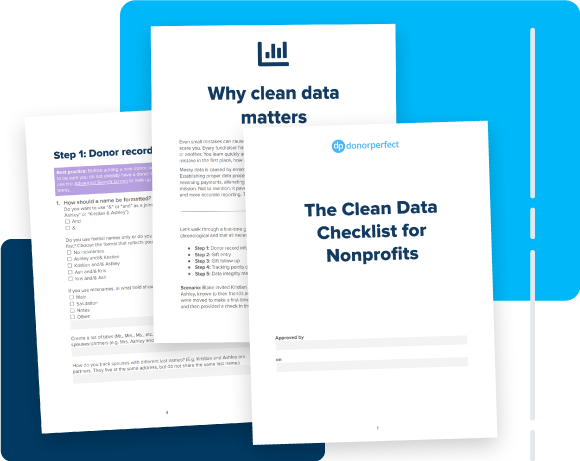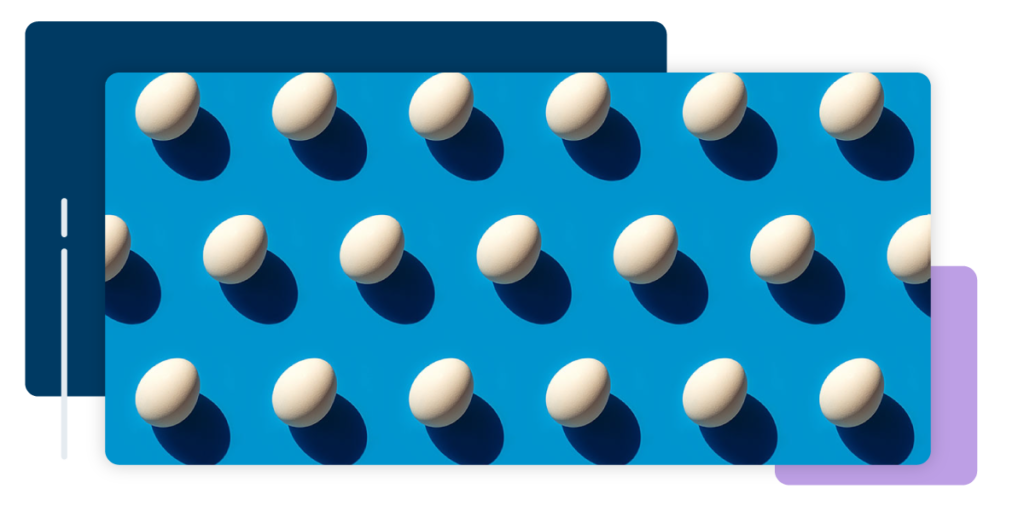Nonprofit Technology & Fundraising Blog
Subscribe to our mailing list

January 27, 2023 | Donor Data, Fundraising Operations
Hear me out. Data cleanup sounds about as exciting as deep cleaning your house, but it actually has the potential to bring your fundraising team closer together. A clean home means a clear head, right? The same is true for a healthy donor database and healthy work relationships.
Each role in your organization has a different relationship with your fundraising data, and a smooth data entry process means keeping everyone on the same page. When each team member is using your nonprofit CRM differently, there could be costly mistakes in your nonprofit’s future. When one team member struggles to complete their tasks, it’s all too easy to feel animosity toward them, your systems, or your job as a whole.
Messy data is caused by errors of omission, duplication, transcription, and more. Establishing proper data procedures saves your organization from issuing corrections, reversing payments, alienating donors, and dipping into funds meant for your mission. Without it, there’s no way to know what details are being omitted, duplicated, or transcribed incorrectly. Not to mention, establishing healthy procedures now will pave the way for effortless CRM maintenance, seamless new hire training, and more accurate reporting.
You host a gala where you encourage attendees to fill out pledge cards at their table placements. The response is amazing – but not all pledge cards are filled out the same. Some donors committed to pay their pledge monthly, with no end date specified, while others were specific about the dates of their payment schedule. Some donated by writing a check for the first month to show they would make good on their commitment, vowing to pay the rest electronically. A couple of your donors even brought friends who expressed interest in learning more about your programs.
Create a resource that outlines proper data procedures for your CRM, including donor records, contact records, gift follow-up, and routine maintenance. Consider special details that may apply specifically to your organization or sector.
Whether or not you fundraise with DonorPerfect, you’re welcome to start with the Clean Data Checklist for Nonprofits – a CRM companion that walks you through each step of the data entry process while providing you with best practices!

We recommend having each member of your team who will be working in your CRM save their own copy of the Clean Data Checklist, or your procedure guide, and fill it out to the best of their ability. Then, get everyone together to compare answers and identify discrepancies. This approach avoids singling someone out or making an example out of anyone. Encourage healthy discourse about which data procedures will elicit the most accurate reports and improve the overall understanding of your donors.
More than likely, your team will see that there are several different ways of completing each data entry task. Your Executive Director may be looking at your data from a completely different vantage point than a Development Director or volunteer. One team member might even have an impressive method that you all agree to put into practice.
Shift the focus of your cleanup meetings from finger-pointing to fun activities like food, games, prizes, or points – however you give recognition at your organization. If you want to keep it simple, you could reward the employees who exhibit impressive data entry techniques or recognize those who are able to propose a better way of doing things.
Another way to get your cleanup team in the collaborative spirit is to try a team-building exercise before getting down to every last detail of data entry. This approach lightens the mood and celebrates the strengths of each person – even if data entry is not one of them, allowing your team to focus on its efficiency instead of any feelings of inadequacy.
Here’s one we’ve done at DonorPerfect:

The Egg Drop Challenge:
Break into several teams. Each team is given the same materials to build a container that will successfully allow an egg to survive a 9-foot drop. At DonorPerfect, we provided two cups, soda straws, paper clips, pencils, a pair of scissors, and three feet of masking tape. Have each team name their device and list three benefits and three features. Consider having someone be a spy for another team, or having someone switch teams halfway through. Once each team has presented its device, share your feelings and reactions. Have a good laugh at your failures and commend each other for your successes.
Strategist – The one who makes decisions
Consider: What information is required to set attainable goals for each campaign? What would make it easier to assign tasks and track their completion? How accurately can you measure one revenue stream against another?
Communicator – The one who handles outreach
Consider: How long does it take to personalize your communications – could it be done automatically? Is your donor information reliable and complete enough to hit “send all”? Do you record conversations that could make great impact stories?
Administrator – The one who processes information
Consider: Do you have naming conventions for campaigns, appeals, and events? Are there inactive codes in the system that should be retired? Do you find that details are missing when you create donor lists?
Networker – The one who puts the word out
Consider: Do you have a set procedure for leveraging your personal connections? Is there information in your CRM that can be used to assess major and matching gift interest? Do you have CRM integrations that send and track mass communications via social media or video?
Data cleanup is a constructive process that promotes cohesion within your nonprofit team and its fundraising efforts, so I hope these exercises help reinvigorate your team to reach optimal data health. As you get started, the Clean Data Checklist is yours to customize and lean on as you establish better data procedures together.
Follow us on social!